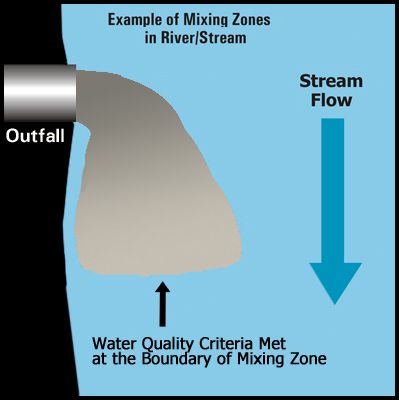Mixing Zones
What is a mixing zone?
A mixing zone is the defined portion of a waterbody where a permitted wastewater discharge undergoes initial dilution. Specific water quality criteria are permitted to exceed the numeric limits for those criteria within this defined area. Water immediately outside the permitted mixing zone is required to meet all water quality criteria.
Mixing zones are allowable in cases where meeting "end of pipe" limits are not practicable1. In Alaska, mixing zones are permitted for municipal wastewater treatment facilities, seafood processors, oil and gas wastewater discharges, mining activities, and cruise ship wastewater discharges. Alaska regulations prohibit mixing zones in spawning areas of anadromous Pacific salmon and certain other fish species.
1. Practicable: 18 AAC 70.900: (48) "practicable" means available and capable of being done after taking into consideration cost, existing technology, and logistics in light of overall project purposes.

Frequently asked questions
What factors must DEC consider when authorizing a mixing zone in a permit? A partial list of factors includes:
- The physical and chemical characteristics of the receiving water
- The physical and chemical characteristics of the proposed wastewater discharge
- The effects of the wastewater discharge on the background water chemistry, including cumulative effects
- The effluent that has been treated to remove, reduce and disperse the pollutants with the most effective, technologically and economically feasible methods
- Any additional measures that would mitigate potential adverse effect(s) to aquatic resources
- The mixing zone will not affect the ability to maintain and protect the designated and existing uses of the waterbody as a whole
- The mixing zone must protect overall biological integrity
- The mixing zone will be as small as practicable
Mixing zones cannot be authorized if the Department determines:
- Create a public health hazard for water supply or contact recreation
- Exceed water quality standards outside the mixing zone
- Cause an adverse effect on fish or shellfish including formation of a barrier to migration, reduction in population, or effect their lifecycle (move, spawn, or grow).
Do federal regulations allow for mixing zones?
- Yes, current federal regulations state that "States may, at their discretion, include in their State standards, policies generally affecting their application and implementation, such as mixing zones, low flows and variances. Such policies are subject to EPA review and approval."
- Title 40: General policies, Part 131, Subpart B: §131.13 General policies.

 Indicates an external site.
Indicates an external site.